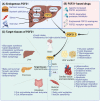Targeting FGF21 in cardiovascular and metabolic diseases: from mechanism to medicine
- PMID: 36594101
- PMCID: PMC9760446
- DOI: 10.7150/ijbs.73936
Targeting FGF21 in cardiovascular and metabolic diseases: from mechanism to medicine
Abstract
Cardiovascular and metabolic disease (CVMD) is becoming increasingly prevalent in developed and developing countries with high morbidity and mortality. In recent years, fibroblast growth factor 21 (FGF21) has attracted intensive research interest due to its purported role as a potential biomarker and critical player in CVMDs, including atherosclerosis, coronary artery disease, myocardial infarction, hypoxia/reoxygenation injury, heart failure, type 2 diabetes, obesity, and nonalcoholic steatohepatitis. This review summarizes the recent developments in investigating the role of FGF21 in CVMDs and explores the mechanism whereby FGF21 regulates the development of CVMDs. Novel molecular targets and related pathways of FGF21 (adenosine 5'-monophosphate-activated protein kinase, silent information regulator 1, autophagy-related molecules, and gut microbiota-related molecules) are highlighted in this review. Considering the poor pharmacokinetics and biophysical properties of native FGF21, the development of new generations of FGF21-based drugs has tremendous therapeutic potential. Related preclinical and clinical studies are also summarized in this review to foster clinical translation. Thus, our review provides a timely and insightful overview of the physiology, biomarker potential, molecular targets, and therapeutic potential of FGF21 in CVMDs.
Keywords: cardiovascular diseases; fibroblast growth factor 21; metabolic diseases; targets; therapeutics.
© The author(s).
Conflict of interest statement
Competing Interests: The authors have declared that no competing interest exists.
Figures



References
-
- Virani SS, Alonso A, Aparicio HJ, Benjamin EJ, Bittencourt MS, Callaway CW. et al. Heart Disease and Stroke Statistics-2021 Update: A Report From the American Heart Association. Circulation. 2021;143:e254–e743. - PubMed
-
- Geng L, Lam KSL, Xu A. The therapeutic potential of FGF21 in metabolic diseases: from bench to clinic. Nat Rev Endocrinol. 2020;16:654–67. - PubMed
-
- Fisher FM, Maratos-Flier E. Understanding the Physiology of FGF21. Annu Rev Physiol. 2016;78:223–41. - PubMed
Publication types
MeSH terms
Substances
LinkOut - more resources
Full Text Sources
Medical

